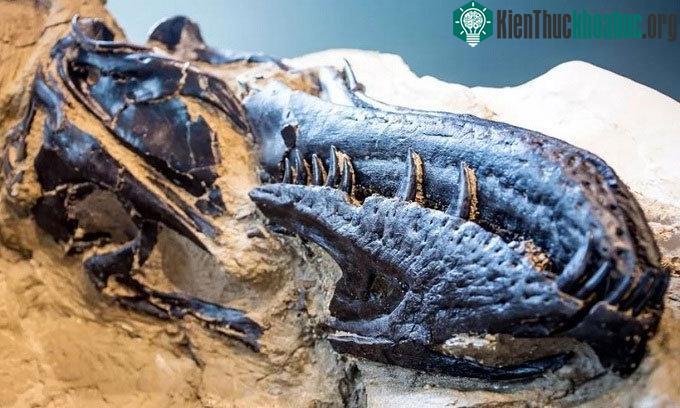The three-horned dinosaur (Ariceratops horridus) and the tyrannosaurus rex (Tyrannosaurus rex) fought and were quickly buried side by side in a grave.
The intact skeletons of these two dramatic dinosaurs will be displayed and studied at the North Carolina Museum of Natural Sciences in Raleigh in 2022, according to a November 17 announcement by the Museum. Both have battle scars.

Fossils of two dead dinosaurs overlapped. (Photo: North Carolina Museum of Natural Sciences).Researchers first discovered the fossil tri-horned dinosaur in 2006 when it was eroded from the sedimentary rock in the Hell Creek Formation. This system is 65.5 million years old. Fossil treasures from the late Cretaceous period stretch across Montana, North Dakota, South Dakota and Wyoming.
Experts also found the body of a tyrannosaur lying on top of a three-horned dinosaur. They separated the fossil mass from the formation, covered it with plaster, and stored it safely until it could be studied. This is one of the most intact dinosaur skeletons in the world. Both skeletons are articulated, meaning all bones are preserved in complete order. Articulated fossils are very rare, but the discovery includes up to two such fossils.

Recreate the battle between the young tyrannosaur and the three-horned dinosaur. (Photo: North Carolina Museum of Natural Sciences).Although the fossils are still attached to sedimentary rocks, researchers can still imagine the story behind from what they have observed. Analysis of 3-horned dinosaur fossils revealed marks on the skin on its frills and hips. The tyrannosaur’s teeth dug into the enemy’s spine. But scientists were not able to clearly observe the forelimbs of the three-horned dinosaur. They are not sure if these limbs folded under its body in the rock or were bitten by another dinosaur before it was buried. The team also wanted to find out what to eat if the dinosaur’s intestines were still intact. If that’s the case, they might consider its last meal.
Most of the tyrannosaurs’ teeth were broken. It also broke a finger and had a fractured skull. The researchers wanted to determine whether all of the injuries were the result of a battle with the three-horned dinosaur, or if it was post-mortem. Tyrannosaurus rex fossils also have marks on the soles of their feet, similar to modern-day emu.
The museum is building a new laboratory called SECU DinoLab to store fossils for display in 2022. It is also a center for scientists to study fossils. The exhibition is expected to last four years. Questions researchers want to answer include determining whether the markings on the skin contain molecules, and whether the dinosaur fossils provide evidence of feathers. They also need to determine if the tyrannosaurs are juveniles and learn more about the tricer’s frill.
Due to the fossils covered by sediment, the body contours, marks on the skin and soft tissues of the dinosaurs are still intact. Usually, these features are lost when fossils are excavated in the field. Fossils could change people’s understanding of two famous dinosaurs, said Lindsey Zanno, head of archeology at the North Carolina Museum of Natural Sciences and an associate professor at the University of North Carolina.
The non-profit organization Friends of Museum donated dinosaur fossils to the museum on November 17. They collect the fossils through a variety of private funds supported by donors.





